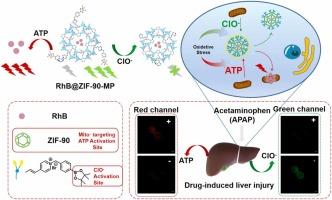双次氯酸盐和腺苷-5 ' -三磷酸响应的ZIF-90纳米体系及其在生物成像中的应用
IF 3.7
1区 化学
Q1 CHEMISTRY, ANALYTICAL
引用次数: 0
摘要
次氯酸离子(ClO−)和腺苷-5 ' -三磷酸(ATP)在各种生理功能中起着至关重要的作用。ClO -和ATP之间的联系已被认为是肝损伤的主要特征之一。采用原位包封罗丹明B (RhB)和连续修饰4-甲基-1-(4-(4,4,5,5-四甲基-1,3,2-二氧杂硼-2-基)苄基)溴化吡啶(MP)制备了基于沸石咪唑酸框架(ZIF-90)的同时鉴定ClO−和ATP探针RhB@MP-ZIF-90。由于电荷从ZIF-90转移到吡啶,这种纳米探针的分散良好的水溶液在绿色通道中具有高发射性。ClO−将探针RhB@MP-ZIF-90中的硼酸酯基氧化为羟基,同时4-亚甲基-环己-2,5-二烯酮被消去,吡啶变为吡啶,阻断ICT,并猝灭绿色发光。相比之下,探针的ZIF-90主干被ATP破坏,释放出RhB,产生特征红色发射。因此,这种易于制备的探针可以在两个独立的通道中通过ClO−触发的荧光减弱和ATP诱导的荧光扩增实现对ClO−和ATP的双重检测,ClO−和ATP的检测限分别为24.94 μM和360 μM。因此,RhB@MP-ZIF-90成功用于监测不同生物过程和药物性肝损伤模型中线粒体ClO−和ATP的浓度变化。本文章由计算机程序翻译,如有差异,请以英文原文为准。

Dual hypochlorite and adenosine-5’-triphosphate responsive ZIF-90 nanosystem and its application for biological imaging
Hypochlorite ion (ClO−) and adenosine-5’-triphosphate (ATP) are crucial in various physiological functions. The connection between ClO− and ATP has been noted as one of the major characteristics of liver injury. This study presents a zeolitic imidazolate framework (ZIF-90)-based probe RhB@MP-ZIF-90 for the simultaneous identification of ClO− and ATP, which was fabricated by in situ encapsulation of rhodamine B (RhB) and successive modification of 4-methyl-1-(4-(4,4,5,5-tetramethyl-1,3,2-dioxa-borolan-2-yl)benzyl)pyridinium bromide (MP). A well-dispersed aqueous solution of this nano-scale probe is highly emissive in the green channel due to the charge transfer from ZIF-90 to the pyridinium. ClO− oxidizes the boronate ester group to hydroxyl in probe RhB@MP-ZIF-90, which is accompanied by the elimination of 4-methylene-cyclohexa-2,5-dienone, changing pyridinium to pyridine, blocking ICT, and quenching the green emission. By contrast, the ZIF-90 backbone of the probe is destroyed by ATP, releasing RhB to generate a characteristic red emission. Thus, this easy-to-prepare probe enabled the dual detection of ClO− and ATP, achieved through ClO−-triggered fluorescence decrease and ATP-induced fluorescence amplification in two independent channels, with detection limits of 24.94 μM for ClO− and 360 μM for ATP, respectively. As such, RhB@MP-ZIF-90 was successfully used to monitor concentration changes of mitochondrial ClO− and ATP in different biological processes and a drug-induced liver injury model.
求助全文
通过发布文献求助,成功后即可免费获取论文全文。
去求助
来源期刊

Sensors and Actuators B: Chemical
工程技术-电化学
CiteScore
14.60
自引率
11.90%
发文量
1776
审稿时长
3.2 months
期刊介绍:
Sensors & Actuators, B: Chemical is an international journal focused on the research and development of chemical transducers. It covers chemical sensors and biosensors, chemical actuators, and analytical microsystems. The journal is interdisciplinary, aiming to publish original works showcasing substantial advancements beyond the current state of the art in these fields, with practical applicability to solving meaningful analytical problems. Review articles are accepted by invitation from an Editor of the journal.
 求助内容:
求助内容: 应助结果提醒方式:
应助结果提醒方式:


